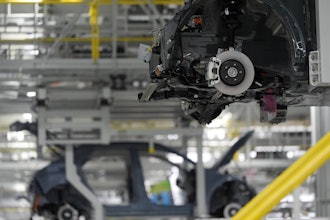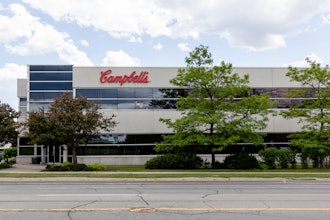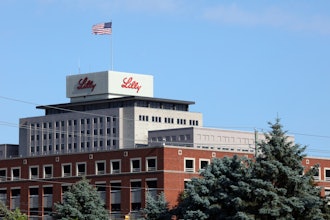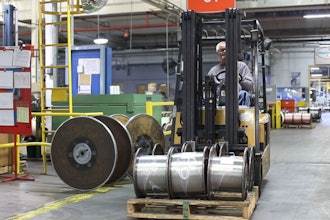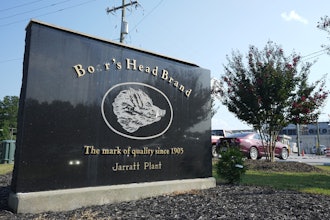Tips for plant managers and maintenance professionals to help streamline the conversion process within their own quality and risk management systems.
Recalls of food and beverage products due to contamination concerns have risen significantly over the last decade. In today's increasingly competitive global economy, food and beverage processors are under more pressure than ever to ensure the safety of their products, protect their brand reputation, enhance their company's productivity and expand profit margins in the face of tightening economic times.
One of the important areas that food and beverage processors need to focus on to help achieve a food safe and hygienic processing environment is lubrication. Using lubricants that are suitable for use in food machinery where incidental food contact may occur will not only help to minimize the potential for product recalls and maintain brand integrity, but can also enhance equipment performance, thanks to advancements in lubricant chemistries.
Food and beverage processing plants often have a wide variety of machinery and converting all of them to NSF registered lubricants can be an overwhelming task. By itemizing equipment, properly storing and handling the equipment, converting the equipment, and establishing a proactive oil analysis program, companies will not have to compromise production goals for incorporating and improving their food quality initiatives.
Itemizing equipment
For a lubricant to achieve product registration from the National Sanitation Foundation for accepted use in food or beverage processing equipment, lubricant manufacturers need to submit product formulations and labels for review by a certified NSF toxicologist. The ingredients used in the lubricant are compared against regulatory requirements including NSF's Registration Guidelines for Proprietary Substances and Nonfood Compounds and 21 CFR. Based on the toxicologists' analysis, a lubricant can be registered as H1, H2 or H3.
H1 lubricants are formulated with base oils and components that comply with FDA 178.3570 and are approved for applications in machinery that could potentially have "incidental contact" with the food or beverage being manufactured. Such compounds may be used on food processing equipment as a protective anti-rust film, as a release agent on gaskets or seals of tank closures, and as a lubricant for machine parts and equipment in locations where there is potential exposure of the lubricated part to food. Equipment such as baking chains, conveyors and mixers require the use of H1 lubricants.
H2 approved lubricants can be used on machinery in a food and beverage processing facility in which there is no possibility that the lubricant or lubricated part will come in direct contact with food. Such applications of an H2 lubricant can include fork lift trucks, transportation equipment, and gearboxes, compressors and hydraulics that do not come in contact with the food/beverage product or components.
H3 are soluble oils that are used for rust prevention on trolleys and similar equipment, but must be removed before food comes into contact with the equipment.
It is important for plant managers and maintenance professionals to itemize each piece of equipment and accurately assess the risk of food contamination potentially caused by the lubricant for every application, according to local HACCP planning procedures. Upon completion, maintenance professionals should then review the list with their lubricant manufacturer or distributor to identify opportunities to select the correct lubricant and also to potentially consolidate the number of necessary products and accurately assess volume.
By minimizing the number of lubricants used and only using NSF H1 registered lubricants, plant managers and maintenance professionals can optimize food safety initiatives, expedite the purchasing process, simplify maintenance procedures, and minimize the opportunity of improperly lubricating equipment.
Properly storing & handling
Following the proper storage and handling procedures for NSF H1 registered lubricants can help maintain the integrity of the product's formulation, so it can provide the anticipated performance characteristics when it's applied to a piece of equipment.
First, maintenance professionals and plant managers should thoroughly examine the lubricants upon delivery. New packaging should not be damaged, especially the package seal. Any damage to the seal could indicate that the lubricant has been potentially contaminated and should not be used.
NSF registered lubricants ideally should be stored inside in a temperature-controlled (+5°C to +25°C), dry storage room and segregated from non-NSF registered products. Each product should be properly labeled and new batches of product should not be topped off with the remainder of lubricant from another batch. It is preferred that maintenance professionals opt for drums of product to maintain stock rotation and throughput.
When dispensing the product, maintenance professionals should use containers clearly marked for the appropriate NSF registered product to avoid any contamination and avoid the need to replace unused oil. Additionally, the use of personal protective equipment is recommended to avoid any unnecessary contact.
Converting to H1 lubricants
There are several advisory steps that need to be followed to convert the lubricant in a piece of equipment from a non-NSF registered food machinery lubricant to an NSF registered product. Each stage should be clearly documented according to HACCP planning.
Step 1: Operate the system under normal conditions until stabilized operating temperature is reached.
Step 2: Drain as much oil from the system as possible. Check filters, reservoirs, etc. while the oil is still warm. Remove solid contaminants.
Step 3: Replace filters.
Step 4: Change the system with sufficient fresh NSF registered oil to ensure full circulation.
Step 5: Operate the system under normal conditions for a minimum of one hour. If the flushing fluid shows signs of contamination from excessive solid or water contamination, through visual or used oil analysis inspection, then repeat Steps 2-5.
Step 6: Fill the system with recommended NSF H1 registered lubricant. Assume normal operation and monitor filters.
Step 7: Clearly label all machinery equipment with the type of lubricant that should be used.
It is advisable to flush gearbox and hydraulic systems when converting from conventional mineral oil to NSF registered lubricants. This will help ensure the integrity of the system and the lubricant. Larger systems with complicated internal structures may require oil analysis to confirm adequate cleanliness.
Establish an oil analysis program
Once the equipment is running with the new NSF registered product, it is imperative for maintenance professionals to monitor its performance to ensure the conversion was done properly. This helps to ensure lubrication performance and system integrity according to HACCP planning. One of the most comprehensive ways to monitor the condition and performance of an oil is through a used oil analysis program.
This type of condition-based monitoring provides maintenance professionals and plant managers with insight into the condition of the oil, as well as the components of the equipment it is lubricating. Using this data, informed decisions can be made about the remaining life of the lubricant. In addition, the data can give valuable information about the condition of the equipment and can be used to address equipment issues before they lead to unscheduled downtime. Applications particularly suitable for a used oil analysis program are hydraulic and gear box equipment, as well as heat transfer systems.
Typically, food and beverage processing companies work with a trusted oil analysis provider and conduct oil analysis approximately every three months.
Food quality first
Converting an entire food or beverage processing facility to NSF registered lubricants can be a large undertaking. However, by following the tips outlined in this article, plant managers and maintenance professionals will be better able to turn it into a manageable task within their local risk management systems, while helping their companies optimize production, promote food quality, and ensure the brand integrity of their products.




